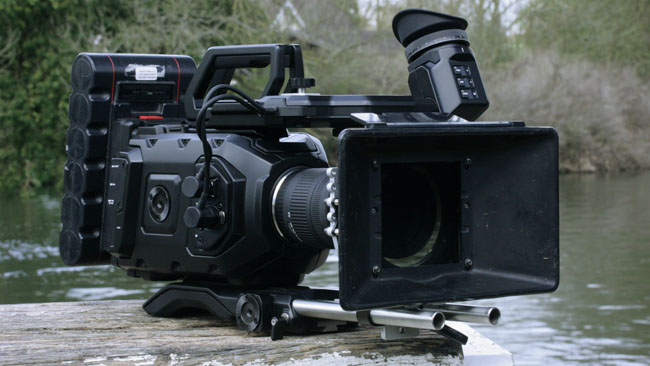
Replay: Opinions about new cameras vary, and sometimes percieved "faults" aren't faults at all.
Don't believe everything you hear on the internet.
While most people are completely familiar with this maxim, there's a number of ways in which the public resistance to online balderdash is easily weakened. Politics and religion are the most well-known "avoid" subjects, of course, but it's amazing how touchy people can get when they've just made, say, a major investment in camera equipment. This is the somewhat dubious motivation that can cause people to become so amazingly attached to the products of one particular manufacturer, whether it's cinema cameras or tomato soup. It's also the reason that online debates about camera equipment, particularly perceived faults, can become so polarised, so quickly.
The case of the Sony FS5
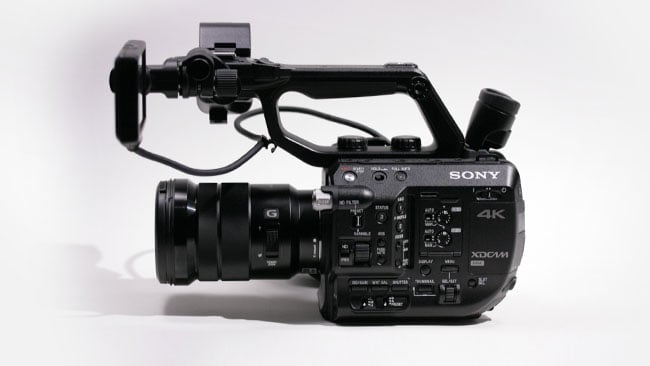 Sony FS5
Sony FS5
We discussed this once a few months ago (at the time of original publication in 2017) with respect to the changes made to the codec and noise reduction settings on the Sony FS5. A survey of internet opinion might have suggested serious problems with noise handling, but in reality it there was nothing fundamentally wrong with the camera. At very high gain settings, provoking a lot of noise, there could be noticeable noise-reduction artifacts. Additionally, the setup of the codec, which in some circumstances prioritised retention of detail over the avoidance of compression artifacts, was not to everyone's taste. The word "taste" is crucial: while the codec setup could occasionally produce banding in the graduated skies, for instance, it was a choice and not a fault. Noise reduction and compression create artifacts. Such is life.
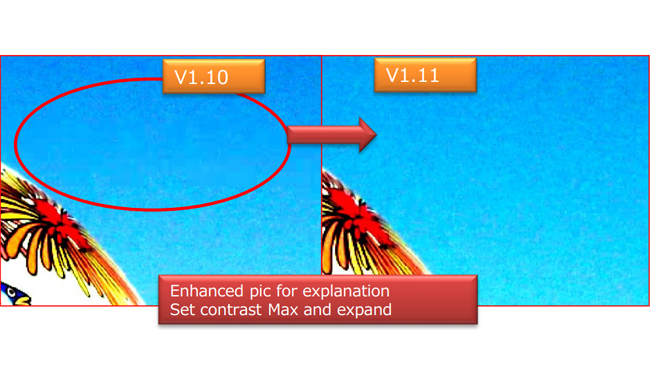 A 100% crop of a 4K frame from the FS5 showing a comparison between V1.10 and 1.11 firmware.
A 100% crop of a 4K frame from the FS5 showing a comparison between V1.10 and 1.11 firmware.
Perhaps Sony would have altered this behaviour anyway. The speed with which the updates were made available suggests that they had been underway for some time before the furore began. The point is, though, that the issue was being discussed in terms massively in excess of its real import. There's every reason to believe that similar things are happening again with regard to Blackmagic's Ursa Mini 4.6K.
4.6K fringing explained
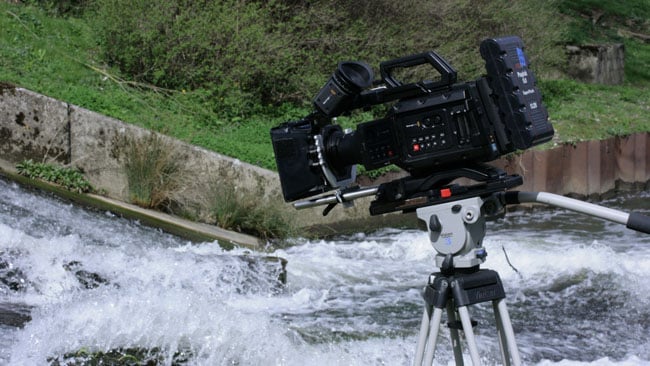 The Ursa Mini's shoulder kit provides for superb ergonomics and compatibility
The Ursa Mini's shoulder kit provides for superb ergonomics and compatibility
with well-established standards for grip equipment.
It's easy to find images from this camera which show magenta fringing in the corners of the frame. Experienced people, on seeing these images, will tend toward what seems to be the correct conclusion: that there's an interaction between certain types of lenses and the sensor in the 4.6K camera. Certain types of lens, particularly old ones, may not be image-space telecentric; that is, the rays of light don't all come out of the lens in parallel. This wasn't much of a problem on film in the days when these older lenses were developed. The various colour-sensitive layers were stacked up and have a finite thickness, but any microscopic misalignment due to that generally wasn't objectionable. It can be considerably more objectionable on digital sensors, mainly because the physical construction can exacerbate the sensitivity of the sensor to non-perpendicular light.
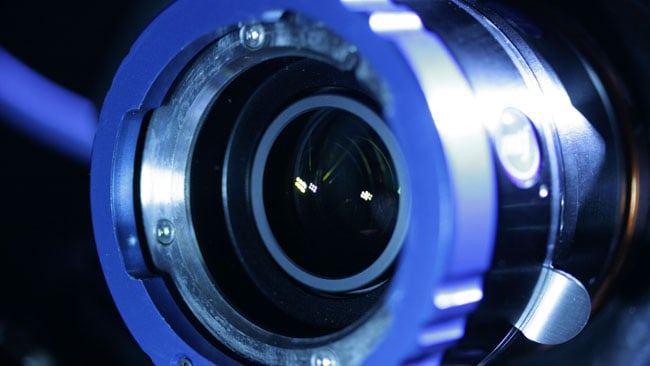 Non-telecentric lenses can require optical correction to satisfy sensors (Courtesy MTF Services).
Non-telecentric lenses can require optical correction to satisfy sensors (Courtesy MTF Services).
In some sensors, the photosensitive area is recessed slightly, at the bottom of a depression. Light entering at an extreme angle may strike the side of the depression at least slightly, meaning that some of the light doesn't end up being read by the photosite. The other source of this issue can come from the use of microlens arrays, where a sheet of tiny lenses is positioned on the front of the sensor. This is intended to counteract the tendency of modern sensors to have poor fill factor, where there are spaces between the photosites, often containing extra circuitry which exists to implement other features. The lenses can meet edge-to-edge and concentrate light into the sensitive areas, which increases sensitivity and decreases aliasing, but the whole arrangement can be rather more sensitive to the angle of incidence than more straightforward approaches.
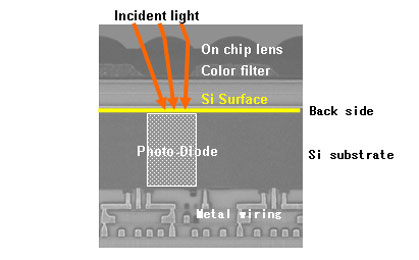 This Sony diagram shows the use of microlenses, which may cause sensitivity to off-angle light.
This Sony diagram shows the use of microlenses, which may cause sensitivity to off-angle light.
All of these techniques are entirely normal and everyday, and they're particularly used on sensors where high performance – in terms of resolution, sensitivity and frame rate – are required. Cinema cameras in general require high performance sensors. The generic, easy-to-understand upshot of all this is that modern lenses are much more likely to be designed to work cleanly on modern sensors, and that a combination of old lenses and new sensors (or even some more modern lenses which weren't designed with these concerns in mind) can cause problems. This is not new; there have been problems with putting old stills lenses on new stills cameras for a decade or more.
The acceptability of this – the consideration as to whether it's a characteristic or a fault – is therefore a matter of degree. Some sensors are more prone to tinted vignetting than others; some lenses cause it more than others. This, I suspect, is the root cause of the online confusion: some people have a combination of gear that provokes the issue and some don't. It also varies depending on the stop the lens is set to, with higher F-numbers reducing the problem because they reduce the number of angles from which light may approach the sensor. Often, the problem is subtle enough to be masked by scene content, depending, again, on exactly what equipment is in use and exactly how it's set up.
Fringe correction?
If we want to consider solutions, there's essentially one thing that can realistically be done about this: that's to implement lens shading correction in the Ursa Mini, in much the same way it has always been done in ENG cameras. It probably could be done and the company will be very aware of potential solutions – again, it's not a new technique and is done all the time. It's also not likely to be a universal solution, given the variability of the problem as iris and zoom settings change.
Ultimately, though, we should remember the influence of the internet echo chamber. I'm not here to make excuses for Blackmagic and, no, I have not been asked by anyone to write this piece and I'm not receiving any reward beyond the usual rate. The problem is that it doesn't take many knee-jerk comments on social media to create a false impression of serious problems with a product and it isn't entirely fair.
Keeping perspective
From what I've seen of it (and I hope to see a lot more), the Blackmagic Ursa Mini 4.6K is a really nice piece of gear, possessed of excellent ergonomics, solid pictures and a viewfinder that's still one of the best currently available. It would be possible to make excuses on the basis that it's only the company's second or third generation of cameras, but at the price, it really doesn't need them. In the future, let's do our best not to leap to the conclusions of the pitchfork-wielding gestalt of social media.
Tags: Production


Comments